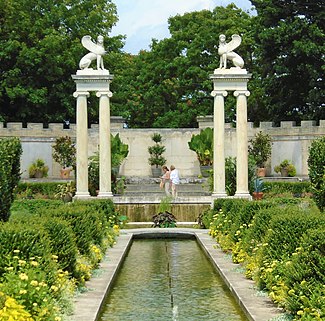Untermyer Park and Gardens | |
 Sphinxes atop paired ionic columns in the amphitheater of the Walled Garden (2020) | |
 Interactive map showing the location for Untermyer Park and Gardens | |
| Location | 945 North Broadway Yonkers, New York |
|---|---|
| Coordinates | 40°58′0″N 73°53′16″W / 40.96667°N 73.88778°W |
| Area | 43 acres (17 ha) |
| Built | c.1916-1940 |
| Architect | William W. Bosworth |
| Architectural style | various |
| NRHP reference No. | 74002263[1] |
| NYSRHP No. | 11940.000003 |
| Significant dates | |
| Added to NRHP | May 31, 1974 |
| Designated NYSRHP | June 23, 1980 |
Untermyer Park and Gardens is a historic 43-acre (17 ha) city public park, located in Yonkers, New York in Westchester County, just north of New York City. The park is a remnant of Samuel Untermyer's 150-acre (61 ha) estate "Greystone". Situated on the steep land arising from the eastern bank of the Hudson River to the bluff on top of it, the park's principal feature is the Walled Garden, inspired by ancient Indo-Persian gardens, in which are found a small Grecian-style open-air amphitheater with two opposing sphinxes crouching atop paired Ionic columns; a classical pavilion; a stoa and loggias; and a circular, open-air tempietto called the Temple of the Sky. A long staircase leads from the Walled Garden to an Overlook with views of the river and the Palisades.
The gardens were developed beginning in 1916 by Untermyer, a prominent lawyer and civic leader, and were designed by architect and landscape designer William W. Bosworth, with fountains by Charles Wellford Leavitt, and sculptures by Paul Manship and other artists. The gardens were regularly opened to the public, hosted performances of noted dancers, actors and musicians, and were considered to be among the finest gardens in the United States.
When Untermyer died in 1940, he had hoped to donate the whole estate to New York Shate Westchester County, or to the City of Yonkers. Eventually Yonkers agreed to accept part of the estate. The parcel, which was the core of the gardens, and which has been added to since that time, was renamed Untermyer Park and Gardens in his honor.[2] It was added to the National Register of Historic Places in 1974.[1]
Untermyer Gardens have recently undergone a significant campaign of restorations, which is continuing.[3]
- ^ a b "National Register Information System". National Register of Historic Places. National Park Service. March 13, 2009.
- ^ Ginsburg, Elizabeth (April 27, 2020). "Untermyer Park". Backyard Gardener.
- ^ [1] Garcia, Ernie. "Untermyer Gardens Rehab Sensational". Westchester Journal News. July 6, 20018

